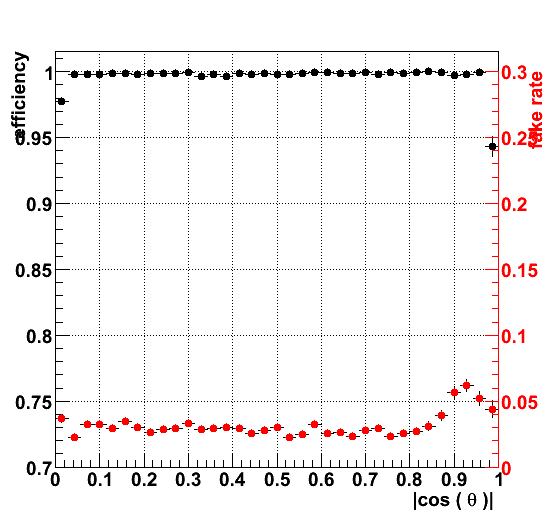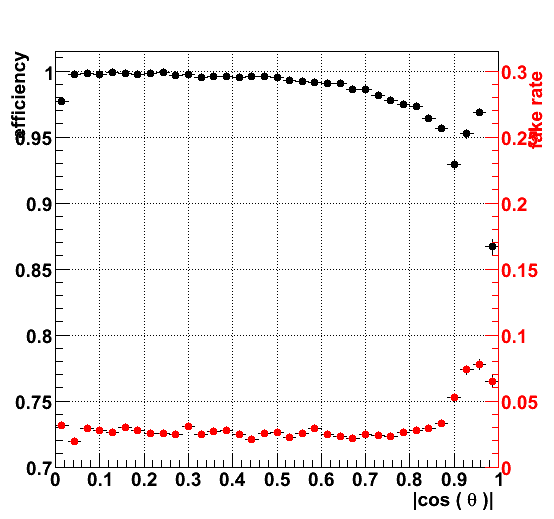|
 Pattern recognition I. Pattern recognition I.
In this section, the pattern recognition performance of several possible detector designs for the very forward tracking region of an ILC experiment is discussed. To study the impact of several parameters - detector segmentation, material budget, integration time - the response of the LDC detector to several 1000 tt events - plus backgrounds - is fully simulated. Events are reconstructed using the current state-of-the-art ILC track reconstruction algorithm. The track collection is analyzed by comparison with the MC truth information: results are presented for the tracking efficiency and fake rate.
For a detailed description of the GuineaPig simulation of the backgrounds, the GEANT4 simulation of the detector response in Mokka or of the FullLDCTracking algorithm in the MarlinReco framework the reader is referred to the Tools section.
Set-up
The geometry model of the detector is the nominal LDC layout. This implies there are five "long barrel" vertex detector layers, two Silicon Intermediate Tracker cylinders at radii of 16 and 30 cm. The central silicon is complemented by seven Forward Tracking Disks on each side of the interaction point. A large central TPC provides up to 180 space points.
Space points are produced from the GEANT4 energy deposits in the sensitive detector volumes by Gaussian smearing with pre-established resolution. The VXD layers provide a resolution of 4 &mu m, both in R &phi and z coordinates. SIT is assumed to provide two-dimensional information with a reduced resolution of 10 &mu m. Finally, the Forward Tracking Disks provide an R &phi measurement with a resolution of 10 &mu m and an R measurement with a nominal resolution of 100 &mu m.
The pT limit for reconstruction - a parameter of the algorithm - is set to 100 MeV.
Results
As a first step of the analysis, a map is constructed that relates (through LCRelations) the MC particles to the reconstructed tracks. The association is performed through the links to MC particles present in the simulated hits. The MC particle list contains particles from the generator AND from the GEANT4 simulation (i.e. secondaries are taken into account in the analysis).
The efficiency is determined by querying the association map with all MC particles. If a reconstructed track is found for which at least 50% of hits stems from this particle, the particle is considered efficiently reconstructed.
The fake rate is obtained by querying the association map with the reconstructed particles. If more than one particle contributes hits to the track, it is considered distorted. This very strict definition includes "distorted tracks", tracks that correspond to a single particle, but for which one or a few spurious hits are picked up.
The results for the FullLDCTracking algorithm (a brief description and links to further documentation are given in the section on Tools) on tt-events without machine background is shown in the figures below. For these results, the analyisis is restricted to "reconstructable particles": particles are required to originate within 10 mm of the primary vertex of the event, and to travel at least 1.5 m in the tracker volume.
In the leftmost figure, the analysis is limited to MC particles and tracks with a pT greater than 1 GeV. The efficiency (black markers) is close to 100% for the full angular range. The fake rate (red markers and Y-axis) is under control and at the two percent level. Only in the very forward region a moderate increase of the fake rate is visible.
In the rightmost figure, all particles are accepted irrespective of their momentum. The performance in the barrel region is quite stable. In the very forward region a significant degradation of the efficiency is observed, as well as an increase of the fake rate.
 
Clearly, the greatest challenge to the FullLDC tracking algorithm on the LDC geometry is formed by low-momentum particles in the very forward tracker region.
Superposition of machine induced background on the signal topology leads to an increase of the number of very forward, low-momentum tracks. The efficiency for these tracks is generally quite low, whether they are part of the signal topology or due to background. Thus, the addition of realistic backgrounds leads to a degradation of the overall efficiency by several %.
In the following section, the pattern recognition of the forward region is studied in more detail.
Home
Next Article
|